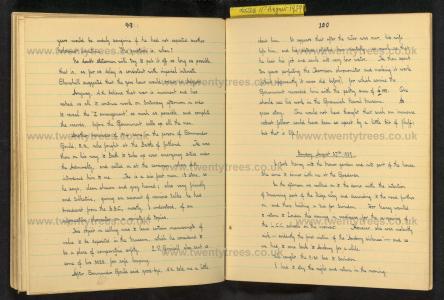Keiller Collection
Keiller Collection is in Prehistory.
Books, Prehistory, Keiller Collection Photos
1934. West Kennet Avenue before excavation.
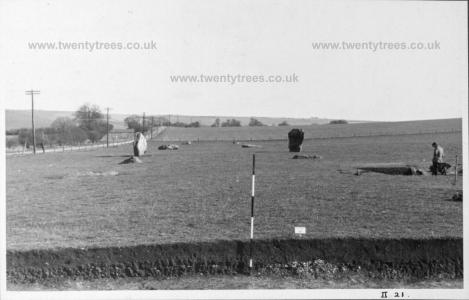
1934. West Kennet Avenue during excavation.
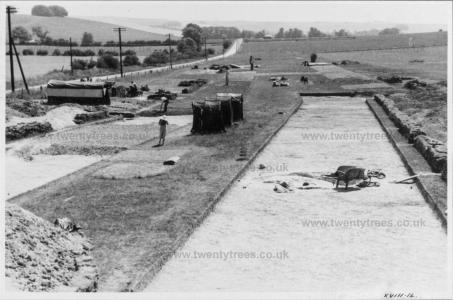
Apr 1914. A photo of Avebury’s bank and ditch. The figures on the bank are thought to be Harold Gray's (age 42) wife Florence Harriet Young (age 38) and their son Lionel St George Gray (age 13).
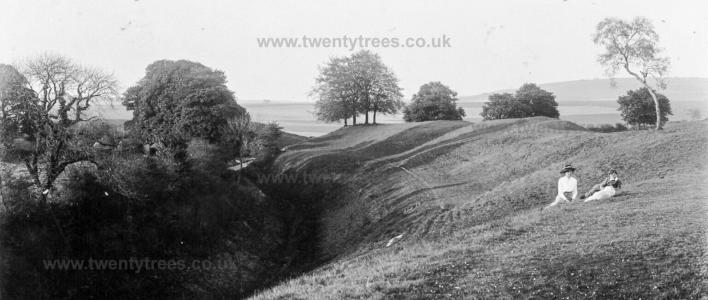
May 1911. Two figures, thought to be Harold Gray's (age 39) wife Florence (age 35) and their son Lionel (age 10), with two stones of Avebury’s Northern Inner Circle.

1908. West Kennet Avenue. Probably Florence Harriet Young (age 32).
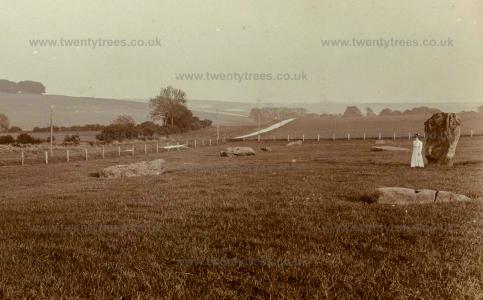
Books, Prehistory, Keiller Collection, Diary of WEV Young
23 Sep 1930. Pages 129-131.
Mr Gray (age 58) called me into the hut at five o’clock and paid me off, remarking as he did so that funds this time were very short (I hope he will get enough for his own “honorarium”). Mrs Gray (age 55) also joined in with a few well chosen remarks, plainly intended for my edification, although addressed to her spouse – “Really dear: I cannot keep on making up the expenses of the excavations, my purse will not allow it. I had to make up five pounds for the Ham Hill work.” … In the presence of Sir Joseph and Lady Bowley, I listened meekly to all this … behaving myself with that gruelling humility one should do, in the presence of their superiors, then touching my ragged cap I backed away, and took my leave.
Books, Prehistory, Keiller Collection Letters
Keiller Collection Letters 14 Feb 1939
Nursling, Southampton,
14th February, 1939.
Dear Sir,
In your February number (p.10) Mr. Keiller (age 49), in his admirable article, quotes a statement that, when megalithic monuments like Stonehenge were built, the level of the Baltic and of the North Sea was 400 feet higher than now! (I need hardly say that Mr. Keiller (age 49) himself is far too sane to attach any importance to such a statement). But it seems at first glance to raise certain difficulties about the construction of Stonehenge. the level of the ground on which Stonehenge stands is about 340 feet above the present level of the sea. A simple calculation shows that it must have then been about 60 feet below the sea!
The explanation of this remarkable fact was mystically revealed to me by no less a person than the chief architect himself, the patriarch Noah. With characteristic frankness he told me of a difficulty that has escaped the notice of all the Biblical critics, and of the ingenious method by which he solved it. The heavy precipitation which resulted in the well-known Flood, consisted, of course, entirely of fresh water; and the fishes who for generations had been born and bred, so to speak, in salt water came to him in great distress, asking his advice. Not being a water expert himself, Noah consulted the Authorities and was told that only strenuous work could save the fish from becoming fossilized. He accordingly devised a scheme by which they should swim across the drowned continent of Eurasia and construct a temple to Jehovah upon the submerged uplands that are now called Salisbury Plain. In order to increase their labour and save them from extinction they were to use only the largest stones, and were to fetch some of them from distant Wales. They were supplied with blue prints by a well-known firm of Sumerian architects, specially drawn on waterproof paper by highly skilled crabs, with ink provided free of charge by cuttle-fish or squids. (It is interesting to note that precisely similar paper is still used by the Ordnance Survey for its small-scale maps). The task was duly carried out, and shortly after 4000 B. C. the temple was formally declared open by a bottle-nosed whale.
In every community, however, there are some recalcitrant individuals who refuse to take good advice, and so there were amongst the fishes. A little group of passive resisters was formed, and they occupied their time swimming round the ark cursing the Authorities. They said they would be fossilized before they would consent to do such menial work, and fossilized they were. When at length the Flood receded, the slopes of Ararat and all the land of Armenia was strewn with huge stone fish. They remain there to this day and may be seen by any who care to visit that country. There is a photograph of one in the Museum at Erivan. They are called VISHAPS and a fully illustrated account of them was recently published (Les Vishaps, by N. Y. Marr & J. I. Smirnov, Leningrad, 1931, reviewed in ANTIQUITY XI, 1937, 122-3).
This explanation is a Revelation in the strict sense of the word. It entirely supersedes the old theory that Stonehenge was built by the Apalachian Indians of North America and dedicated to Apollo1; and of course puts out of court the fantastic conclusions of archaeologists which are invariably built upon the insecure basis of ascertained fact. I might add that Noah informed me that he was always at the disposal of genuine seekers after knowledge, and that his best inspiration came from Chambery No. 5 served with pigs’ trotters, preferably at the Escargot d’Or.
Yours faithfully,
(signed) OGSC (age 52)
The Editor Modern Mystic 6 Bear Street, Leicester Square, W.C.2
Note 1. W. S. Blacket, Researches into the Lost Histories. of America, 1883, p. 193.
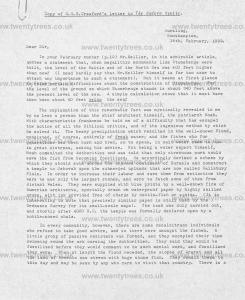
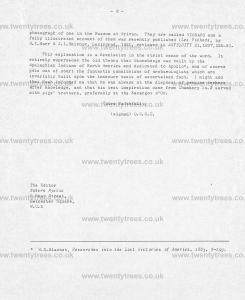
Keiller Collection Letters 24 Oct 1937
24th October, 1937. Alexander Keiller (age 47) to Vere Gordon Childe (age 45).
Dear Childe,
Very many thanks indeed for your letter of the 10th which I would have answered before but, when it arrived, I was up with Influenza. I got up sooner than I should in order to return to the site of excavations in the north—weetern sector which are still in procreee and, not unnaturally, caugnt another chill and retired to bed again.
I do hope that we meet soon for I fear that your experiences as the guest of the Gazi will have laid a mantle of amnesia over your transatlantic [?].
Raymond Firth must have misunderstood my letter completely if, as you say, he though that I was irritated with R.A.I. becauoe J. Foster called himself a "Fellow" thereof. Why I wrote to Firth on the matter at all was that Foster Forbes (age 48) consistently advertised the fact that he was "F.R.A.I., F.S.A." that it would be an excellent thing both these organisations forwarded a protest to the B.B.C., lest that consumately complacent body considered that these two learned Societies concurred with J.F.F.s fantastic statements, and that their silence might be taken to weigh the scales against the more articulate objctions of The Prehistoric Society, The Wilts Archaeological Society, The Hampshire Field Club and others. The Prehistorlc Society are discussing the matter on Wednesdat and will certainly send a strongly worded protest. Equally naturally, the Society of Antiquaries of London propose to do nothing about the matter at save that. "the President wili probably speak to Reith about it if he a chance when he next sees him". The Society of London have for so many yeare adopted the methods towards prehistory of the Duke of Plaza Toro that one would hardly expect them to do anything else than, actually nothing at all.
Reverting again to Firth and the R.A.I. believe no one realises better than I that such initials after one'e nane mean nothing beyond the fact that one hae been interested enouch to pay a couple of guineas or so annually for the right to use the library of the Institution. Personally I never put any letters after my name if I can avoid it, unless F.G.S. if I happen to be writing on geological subjects iun a vain hope that I may convey to my readers I that I am justified in doing so. I was going to say that, having resigned from The Royal Philatelic Society I cannot now utilise the initials "F.R.P.S." which used to give the impression that I had a commercial if not technical knowledge of Chemistry.
Needless to say I agree with everything you say concerning J. Foster Forbes (age 48). Kendrick wrote to me the other day and suggested that two reputable arehaeologists should broadcast talks contraverting Foster Forbe's fantastic statements. I have since heard from the B.B.C. concerning Kendrick's suggestion that I should be one of those selected but, owing to illness, as I say, I have not yet had an opportunity of answering either Kendrick of the B.B.C. The most important this was that the B.B.C. told me they had writted to you to ask you to undertake the frist broadcast. I do most sincerely hope that you will see your way to consent for, when I first got Kendrick's letter your name naturally sprang to my mind as being the most suitable person to undertake the task. Why I should have asked to be the second I cannot imagine, for i could, as I am sure that you could too, instantly name half-a-dozen men very much more competent to undertake the job than I.
After all I but an archaeological surveyor and excavator when all is said and done. I do not lay and never have laid claim to being a "savant" as regards comparative archaeology. I can contravert Foster Forbes' (age 48) statements concerning Avebury, or the megalithic monuments in the north—east of Scotland, but so can plenty of other people who can hold the publie interest better than could I on wider aspects of the subjecty so unsatisfactorily traversed by J. Foster Forbes (age 48).
I am writing to the B.B.C. to suggesting to them that, apart altogether frocu these two immediate talks, a series of talks should be given, say once a fortnight, beginning shortly after the New Yeur and dealing respectively with various periods of British prehistory. In this case, unless more suitable names ware suggested something on the following lines might be adopted:
Palaeolithic (Burkitt).
Mesolithic (Clarke).
Neolithic (Myself, or anyone else who is preferred).
Bronze Age (Piggott or Stone).
Early Iron Age (Hawkes).
Roman (Collingwood).
Saxon and Dark Agee (Kendrick) .
With a summary of the whole to round up the course by O.G.S. Crawford. Alternatively, instead of dividing prehistory into the above hidebound compartments, certain of the talks might represent the transitionary period of one into the next,
Mesolithic — Neolithic (Clarke)
Neolithic — Early Bronze Ace ( Pit.•gott).
Bronze Age — Early Iron Ace (Hawkes).
and so on. Whnt do you think of the Idea?
Anyhow I do hope that you consent to the B.B.C's invitation, and that when you do you will give J. Foster Forbes the sheer undiluted hell that he so richly deserves and for which with sucg unparallel verbosity he has demonstrably asked.
Best wishes to you from all of us here,
Yours sincerely
John Foster Forbes: In 1889 he was born at Rothiemay Castle, Aberdeenshire. In Jul 1958 he died in the Brighton General Hospital after complications following an operation for peritonitis.
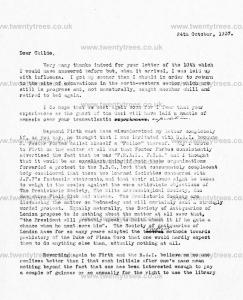
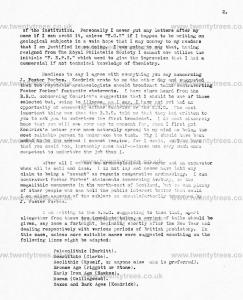
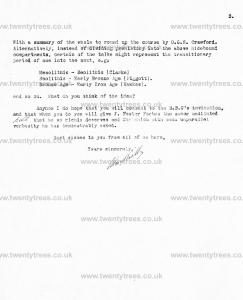
Books, Prehistory, Keiller Collection, Denis Grant King's Diary
Denis Grant King's Diary Pages 97 and 98
26 Aug 1939. Denis Grant King's Diary Pages 97 and 98.
Saturday, August 26th 1939
Beautiful sunny weather that must remind the older folk of August 1914. It is difficult to believe in the reality of the international crisis, or indeed that the human race lacks the intelligence and good will to compose its differences without recourse to war. Still, the forces which lead nations to war gather momentum in fair weather and in foul; and every intelligent person who has lived and observed events during the past twenty years would be unduly sanguine if he had not expected another holocaust sometime. The question is, when?
No doubt statesmen will try to put it off as long as possible, that is, as far as delay is consistent with imperial interests. Churchill suggested that the zero hour would occur in August.
Anyway, Alexander Keiller (age 49) believes that war is imminent and has asked us all to continue work on Saturday afternoon to reveal the “Z arrangement” as much as possible, and complete the records, before the Government calls up all the men.
Another reminder of 1914 came in the person of Commander Gould, R.N., who fought at the Battle of Jutland. He was then on his to way to Bath to take up duties under the Admiralty and called in at the caravan, where Alexander Keiller (age 49) introduced him to me. He is a six foot man, 18 stone, so he says, clean shaven and grey hair; also very friendly and talkative, giving an account of various talks he had broadcast from the B.B.C., mostly, I understood, of an informative character on a variety of topics.
His object in calling was to leave certain manuscripts of value to be deposited in the Museum, which he considered to be a place of comparative safety. L.V. Grinsell also sent us some of his MMS [manuscripts] for safe keeping.
After Commander Gould said good-bye, Alexander Keiller (age 49) told me a little about him. It appears that after the War was over, his wife left him, and his distress affected him mentally, so much so that he lost his job and sank into very low water. He then spent ten years perfecting the Harrison chronometer and making it work (which apparently it never did before), for which service the government rewarded him with the paltry sum of £100. One should see his work in the Greenwich Naval Museum. A queer story. One would not have thought that such an immense robust fellow could have been so upset by a little bit of fluff; but that is life!”
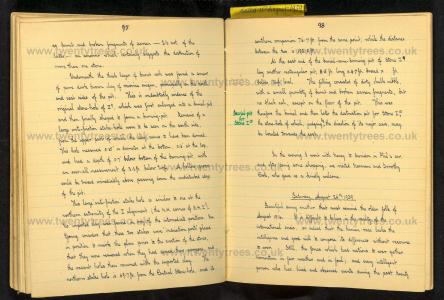
Denis Grant King's Diary Pages 99 and 100
27 Aug 1939. Denis Grant King's Diary Pages 99 and 100.
